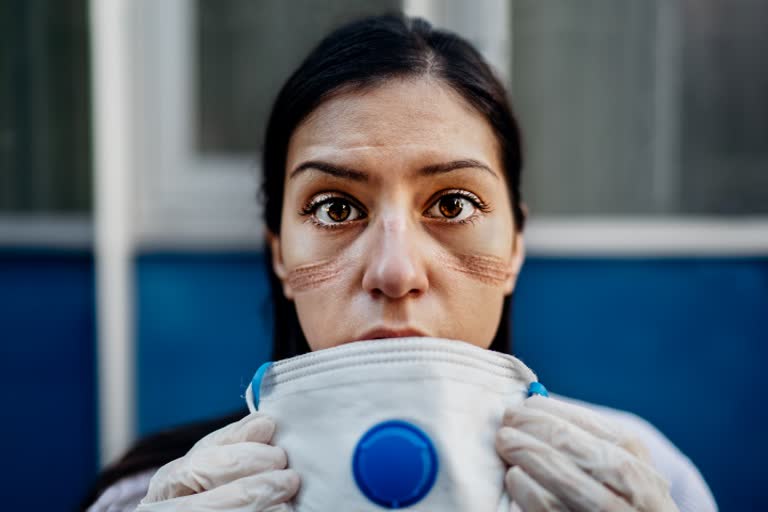At present, the use of masks is very common and the incidence of allergies caused by mask contact has increased. Polyurethanes which are being used commonly in the production of various products including the sponge strip inside the mask may cause Allergic contact dermatitis (ACD).
Allergic contact dermatitis due to masks, gloves, and hand sanitizers
Face masks that are too tight or made of fabric that is scratchy or uncomfortable can rub against the face causing irritation. Some masks may absorb natural moisture on your face thereby drying out your skin. Symptoms of such facial eczema can include red or blotchy skin, itchiness, dry skin with flaking, stinging,or burning sensation.
Skin reactions due to hand gloves are burning crusty skin fissuring patches. Glove powder is often seen to be the culprit.
ACD due to frequent hand washing and use of hand sanitizers.
Prolonged skin exposure to water and humid environment increases skin permeability and sensitivity. To chemical irritants. Repeated use of soaps can remove skin surface oils leading to chronic cumulative irritant contact dermatitis
The WHO says that using hand rubs that contain at least 60% alcohol is a reasonable alternative if water and soap are not available; frequent use of these products can result in dryness and irritation.
Who are at risk?
- Hairdressers, Beauticians.
- Construction workers.
- Metalworkers.
- Healthcare workers.
- Auto mechanics.
- Cleaners.
- Gardeners.
- Agricultural workers.
When to seek professional help?
- The sudden appearance of an itchy, red rash.
- The rash spreads to other body parts.
- The rash does not improve over weeks.
- Skin looks infected – there is the discharge of pus.
- Fever.
Treatment of contact dermatitis:
- The first thing to do is to figure out the cause of the reaction and to avoid contact with the irritant or allergen that triggers dermatitis. This allows the skin to heal and prevents further flare-ups.
- Wash the skin with a bar of bland soap and water.
- Cool compresses help to control inflammation and itching. Soaking in saline or Burrow’s solution (solution of aluminum acetate) gives additional relief.
- Avoid application of Dettol, Savlon, etc. because the skin is already inflamed and irritated.
- Application of hypoallergenic, fragrance-free moisturizer soothes the skin and restores the skin outermost layer, and relieves itching.
- In severe cases, prescription medicines are needed. If the rash is secondarily infected, oral antibiotics may be needed. Steroid-based creams are frequently prescribed to smoothen the rash. Asteroid cream may be applied once or twice a day for two to four weeks. In severe cases, your doctor may prescribe oral corticosteroids and antihistamines to relieve the itching and reduce inflammation.
Ways to prevent facial eczema due to wearing a face mask:
- Use a gentle cleanser, pat dry the skin, and then add a moisturizer before and after wearing the mask.
- Take a break from wearing a mask whenever you can.
- Wash your cloth mask often. The Centre for Disease Control (CDC) recommends you wash your mask after every use.
- Make sure ur mask is completely dry before wearing it again.
Also Read:Skin Problems That Indicate Serious Underlying Health Issues.
Management of ACD due to hand rubs and hand gloves:
- After hand washing, apply a moisturizer liberally, multiple times immediately after hand washing.
- Thick greasy creams provide a higher degree of protection than lotions.
- People with sensitive skin should consult a dermatologist immediately.
Dermatitis:Refers to the inflammation of the skin. It can be of two types; Allergic contact dermatitis and Irritant contact dermatitis.
Allergic contact dermatitis (ACD):Occurs when the substance to which you are allergic triggers an immune reaction in the skin. If the allergen is strong, a single exposure is sufficient to sensitize a person. Multiple exposures are needed if the allergen is weak. Once sensitization occurs, even a small amount of allergen can cause a reaction.
Irritant Contact Dermatitis:This is the most common type. It occurs when a substance damages the skin's outer protective layer. Some people react to strong irritants after a single exposure; others may develop signs and symptoms after repeated exposures to even mild irritants; still, some people may develop a tolerance to the substance over time.
